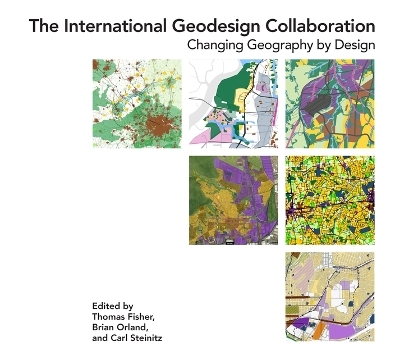
The International Geodesign Collaboration
Environmental Systems Research Institute Inc.,U.S. (Verlag)
978-1-58948-613-3 (ISBN)
- Titel ist leider vergriffen;
keine Neuauflage - Artikel merken
The world faces challenges that supersede and ignore national and regional boundaries and cannot be solved by a single individual, nation, science, or profession. Preparing for the outcomes of population growth and rising global temperatures requires multidisciplinary approaches and collaboration amoung all the stakeholders. Global social and environmental issues will increasingly become multiregional and multinational, and we therefore will need to plan in what should become one language. The language of geodesign.
In The International Geodesign Collaboration: Changing Geography by Design, editors Thomas Fisher, Brian Orland, and Carl Steinitz introduce you to a geodesign approach that allows multiple disciplinary teams to collaborate and design at geographic scale using geographic information systems (GIS) and design tools to explore alternative future scenarios.
Learn The International Geodesign Collaboration workflow for addressing the complex global challenges when working on widely diverse, multidisciplinary projects.
Explore the potential futures of 51 university project areas around the world.
The International Geodesign Collaboration: Changing Geography by Design shows how researchers, scientists, designers, and students, can use geodesign principles to work together through analysis, technology, and collaboration.
Thomas Fisher, is Director of the Minnesota Design Center, and Dayton Hudson Chair in Urban Design, He is a graduate of Cornell University in architecture and Case Western Reserve University in intellectual history, was previously the Editorial Director of Progressive Architecture magazine. Recognized in 2005 as the fifth most published writer about architecture in the United States, he has written 9 books, over 50 book chapters or introductions, and over 400 articles in professional journals and major publications. Named a top-25 design educator four times by Design Intelligence, he has lectured at 36 universities and over 150 professional and public meetings. He has written extensively about architectural design, practice, and ethics. His newest book is Designing our Way to a Better World (University of Minnesota Press, 2016). Brian Orland is the Rado Family Foundation/University of Georgia Foundation Professor of Geodesign at the University of Georgia, College of Environment + Design. He holds degrees in Architecture and Landscape Architecture. His teaching and research focus on environmental perception, the understanding and representation of environmental impacts, and the design of information systems for community-based design and planning. His work includes the use of serious games, visualization and mobile devices for data collection, information dissemination, and citizen engagement in landscape design and planning. Current interests include Georgia coastal residents' intentions to migrate in the face of climate-related change the roles of cultural information in regional planning, and a university global collaboration project, Changing our Global Infrastructure, with Esri and Geodesignhub. Carl Steinitz is the Alexander and Victoria Wiley Professor of Landscape Architecture and Planning, Emeritus, at the Graduate School of Design, Harvard University. In 1967, Professor Steinitz received his PhD degree in City and Regional Planning, with a major in urban design, from the Massachusetts Institute of Technology (MIT). He also holds the Master of Architecture degree from MIT, and a Bachelor of Architecture degree from Cornell University. His applied research and teaching focus on highly valued landscapes that are undergoing substantial pressures for change. He is principal author of Alternative Futures for Changing Landscapes (Island Press 2003), author of A Framework for Geodesign (Esri Press, 2012), and a founding coordinator of the International Geodesign Collaboration. Professor Steinitz received many honors, including the Outstanding Practitioner Award from the International Society of Landscape Ecology (1996), and the Carpenter Teaching Medal from the American Society of Landscape Architects (2015).
Foreword by Jack Dangermond
Part I: The International Geodesign Collaboration
Improving our global infrastructure
Geodesign systems
Design assumptions
Geodesign innovations
Part II: Geodesign projects
How to read the projects in this book
Leibniz University Hannover, Germany
University of Georgia, United States
Beijing Forestry University, China
University College London, United Kingdom
Leibniz University Hannover, Germany
University of Ljubljana, Slovenia
Peking University, China
Università di Cagliari, Italy
The University of Manchester, United Kingdom
The Pennsylvania State University, United States
Hochschule Weihenstephan-Triesdorf, Germany
Politecnico di Milano, Italy
Tohoku University, Japan
Harvard University, United States
Harran University, Turkey
Virginia Polytechnic Institute and State University, United States
Ankara University, Turkey
University of Buenos Aires, Argentina
University of New South Wales, Australia
University of Thessaly, Greece
Ahmadu Bello University, Nigeria
Chulalongkorn University, Thailand
Ritsumeikan University, Japan
California State Polytechnic University, Pomona, United States
National Sun Yat-sen University, Taiwan
Iowa State University, United States
University of Seoul, South Korea
Oregon University System, United States
California State Polytechnic University, San Luis Obispo, United States
University of Virginia, United States
National University of Singapore, Singapore
Leibniz University Hannover, Germany (Lahn River region)
University of Illinois, Urbana-Champaign, United States
Universidade de São Paulo, Brazil
Federal University of Minas Gerais, Brazil
School of Environment and Architecture, Mumbai, India
Universidad Autónoma Metropolitana, Mexico
Swedish University of Agricultural Sciences, Sweden
University of Southern California, United States
University of North Carolina at Charlotte, United States
University of Basilicata, Italy
Texas A&M University, United States
Universidad Simón Bolívar, Venezuela
University College Dublin, Ireland
Georgia Institute of Technology, United States
Hiroshima University, Japan
San Diego State University, United States
University of California, Berkeley, United States
The University of Tokyo, Japan
Addis Ababa University, Ethiopia
National Institute for Environmental Studies, Japan
Part III: Reflections
IGC 2019: What we learned
How geodesign processes shaped outcomes
The natural language of geodesign
Individual relections
Afterword and the direction forward
| Erscheinungsdatum | 07.04.2020 |
|---|---|
| Verlagsort | Redlands |
| Sprache | englisch |
| Maße | 279 x 254 mm |
| Themenwelt | Informatik ► Programmiersprachen / -werkzeuge ► NET Programmierung |
| Technik ► Architektur | |
| ISBN-10 | 1-58948-613-7 / 1589486137 |
| ISBN-13 | 978-1-58948-613-3 / 9781589486133 |
| Zustand | Neuware |
| Haben Sie eine Frage zum Produkt? |
aus dem Bereich


